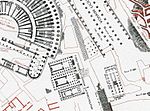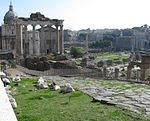Sant'Omobono Area

The Sant'Omobono Area (Italian: Area di Sant'Omobono) is an archaeological site in Rome next to the church of Sant'Omobono, at the junction of via L. Petroselli and il Vico Jugario at the foot of the Campidoglio. It was discovered in 1937 and contains much important evidence for archaic and republican Rome. It contains altars and the sites of the temple of Fortuna and the temple of Mater Matuta. The temples and their sanctuaries lie between the Forum Holitorium and the Forum Boarium. As of 2012, the archaeological site is under re-investigation by a joint team from the Sovraintendenza ai Beni Culturali of the Comune di Roma, the Università della Calabria, and the University of Michigan.The site of Sant'Omobono is crucial for understanding the related processes of monumentalization, urbanization, and state formation in Rome in the late Archaic period. The Sant'Omobono temple site dates to 7th–6th century BCE, making this pair the oldest known temple remains in Rome.
Excerpt from the Wikipedia article Sant'Omobono Area (License: CC BY-SA 3.0, Authors, Images).Sant'Omobono Area
Via Luigi Petroselli, Rome Municipio Roma I
Geographical coordinates (GPS) Address External links Nearby Places Show on map
Geographical coordinates (GPS)
| Latitude | Longitude |
|---|---|
| N 41.8906 ° | E 12.4813 ° |
Address
Templi dell'Area Sacra di Sant'Omobono
Via Luigi Petroselli
00153 Rome, Municipio Roma I
Lazio, Italy
Open on Google Maps









